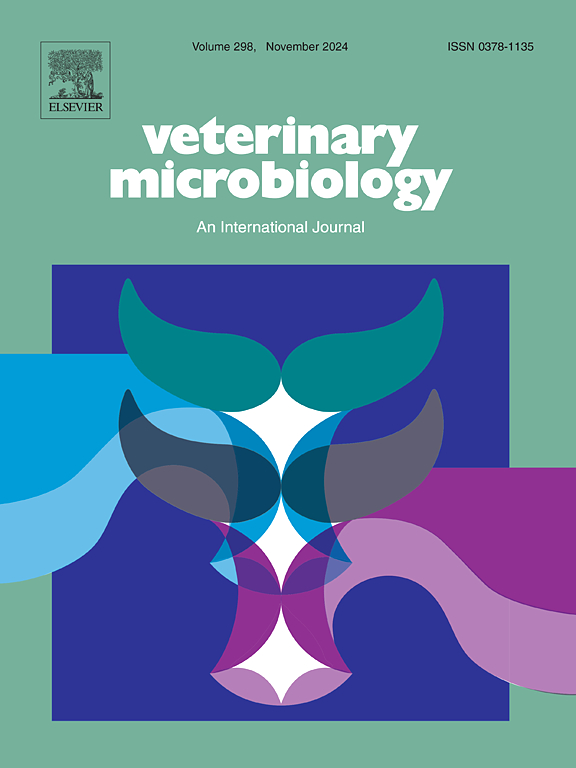lpfD基因对沙门氏菌生物膜形成的影响
IF 2.7
2区 农林科学
Q3 MICROBIOLOGY
引用次数: 0
摘要
沙门氏菌生物膜(BF)的形成对持续感染至关重要,菌毛粘附是关键。编码长极毛(LPF)顶端粘附素的lpfD基因在BF发育中的调控作用尚不清楚。本研究采用全基因组测序方法鉴定高bf形成菌株DSE06与低bf形成菌株DSK01之间的lpfD基因差异。分子生物学技术构建了lpfD敲除菌株DSE06-ΔlpfD、补充菌株DSE06-CΔlpfD和重组菌株DSK01-lpfD(+)。采用培养、结晶紫染色、扫描电子显微镜(SEM)和透射电子显微镜(TEM)分析菌株的生长曲线和BF形成情况。比较其对Caco-2细胞的粘附和侵袭效率,并检测BF关键基因csgD、csgA和csgB的mRNA表达。结果表明,基因修饰对细菌生长没有影响。在野生型、敲除型、补充型和重组型菌株中,DSE06-ΔlpfD的bf形成能力显著降低(P <; 0.01),而DSK01-lpfD(+)的bf形成能力显著增强(P <; 0.01),DSE06-CΔlpfD的bf形成能力部分恢复。菌株DSE06和菌株DSK01-lpfD(+)形成的BF呈密集的网状结构,而菌株DSE06则呈分散分布-ΔlpfD。lpfD的缺失并未改变LPF的超微结构形态。与DSE06、DSE06-CΔlpfD和DSK01-lpfD(+)菌株相比,生成的DSE06-ΔlpfD菌株的粘附率和侵袭率显著降低。在DSE06-ΔlpfD菌株中,csgD、csgA和csgB的表达量较DSE06菌株显著降低(P <; 0.01)。这些结果强调了lpfD基因在沙门氏菌BF形成中的关键作用及其对控制感染的潜在影响。本文章由计算机程序翻译,如有差异,请以英文原文为准。
Effects of the lpfD gene on biofilm formation in Salmonella
Salmonella biofilm (BF) formation is crucial for persistent infections, with fimbrial adhesion being key. The regulatory role of the lpfD gene, encoding the tip adhesin of long polar fimbriae (LPF), in BF development is not well understood. This study used whole-genome sequencing to identify the lpfD gene difference between high-BF-forming strain DSE06 and low-BF-forming strain DSK01. Molecular biology techniques created the lpfD knockout strain DSE06-ΔlpfD, complemented strain DSE06-CΔlpfD, and recombinant strain DSK01-lpfD(+). Growth curves and BF formation of these strains were analyzed using culturing, crystal violet staining, SEM, and TEM. Adhesion and invasion efficiencies on Caco-2 cells were compared, and mRNA expression of key BF genes csgD, csgA, and csgB was evaluated. Results showed genetic modifications did not influence bacterial growth. Among wild-type, knockout, complemented and recombinant strains, the BF-forming capacity of the DSE06-ΔlpfD was significantly reduced (P < 0.01), whereas the DSK01-lpfD(+) demonstrated a significant enhancement (P < 0.01), the DSE06-CΔlpfD exhibited a partial restoration. BF formed by the DSE06 and the DSK01-lpfD(+) strains displayed dense net structures, in contrast to the dispersed bacterial distribution in DSE06-ΔlpfD. The deletion of lpfD did not alter the ultrastructural morphology of LPF. Compared to the DSE06, DSE06-CΔlpfD, and DSK01-lpfD(+) strains, the DSE06-ΔlpfD strain generated showed significantly reduced adhesion and invasion rates. In the DSE06-ΔlpfD strain, the expression of csgD, csgA, and csgB was significantly reduced compared to the DSE06 strain (P < 0.01). These results highlight the lpfD gene's crucial role in Salmonella BF formation and its potential impact on controlling infections.
求助全文
通过发布文献求助,成功后即可免费获取论文全文。
去求助
来源期刊

Veterinary microbiology
农林科学-兽医学
CiteScore
5.90
自引率
6.10%
发文量
221
审稿时长
52 days
期刊介绍:
Veterinary Microbiology is concerned with microbial (bacterial, fungal, viral) diseases of domesticated vertebrate animals (livestock, companion animals, fur-bearing animals, game, poultry, fish) that supply food, other useful products or companionship. In addition, Microbial diseases of wild animals living in captivity, or as members of the feral fauna will also be considered if the infections are of interest because of their interrelation with humans (zoonoses) and/or domestic animals. Studies of antimicrobial resistance are also included, provided that the results represent a substantial advance in knowledge. Authors are strongly encouraged to read - prior to submission - the Editorials (''Scope or cope'' and ''Scope or cope II'') published previously in the journal. The Editors reserve the right to suggest submission to another journal for those papers which they feel would be more appropriate for consideration by that journal.
Original research papers of high quality and novelty on aspects of control, host response, molecular biology, pathogenesis, prevention, and treatment of microbial diseases of animals are published. Papers dealing primarily with immunology, epidemiology, molecular biology and antiviral or microbial agents will only be considered if they demonstrate a clear impact on a disease. Papers focusing solely on diagnostic techniques (such as another PCR protocol or ELISA) will not be published - focus should be on a microorganism and not on a particular technique. Papers only reporting microbial sequences, transcriptomics data, or proteomics data will not be considered unless the results represent a substantial advance in knowledge.
Drug trial papers will be considered if they have general application or significance. Papers on the identification of microorganisms will also be considered, but detailed taxonomic studies do not fall within the scope of the journal. Case reports will not be published, unless they have general application or contain novel aspects. Papers of geographically limited interest, which repeat what had been established elsewhere will not be considered. The readership of the journal is global.
 求助内容:
求助内容: 应助结果提醒方式:
应助结果提醒方式:


